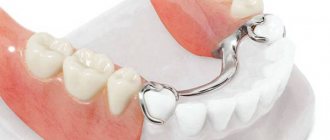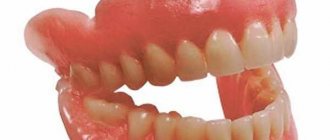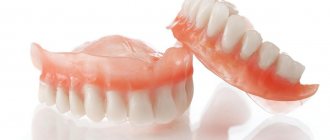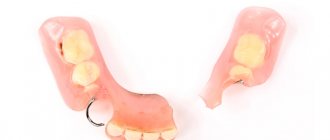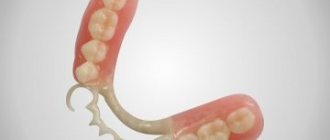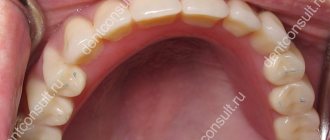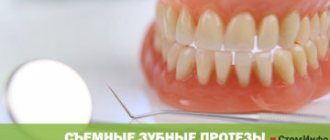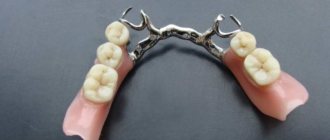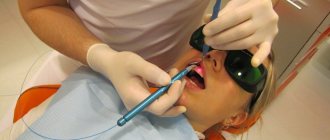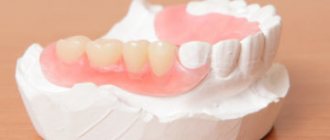August 15, 2020 Last revised: January 18, 2020 Prosthetics
If you lose one or more teeth, dentures can help. A denture will not only hide external defects, but will also allow you to chew food normally. There are two main types of dentures - removable and fixed dentures. Let's take a closer look at the last type.
What are fixed dentures?
Fixed dentures are fixed in the patient's mouth. They are a crown that is “put on” the tooth. It is almost impossible to remove them yourself. These types of dentures do not need to be removed from the mouth and stored in a special liquid. Fixation occurs on previously sharpened teeth. Previously, during the installation of a fixed prosthesis, a depulpation operation was performed - removal of nerves. However, as a result of this operation, the nutrition of the tooth is disrupted, which can lead to undesirable consequences. Therefore, modern dentists do not perform pulp removal, limiting themselves to directly installing the prosthesis.
Only three stages
As we said earlier, there are only three stages in the manufacture of fixed dentures:
- Implantation of implants - the basis for a future prosthesis;
- Determining the impression and setting the correct bite;
- Manufacturing the system from suitable materials.
The technique of making permanent structures is used daily in the Teeth in One Day network of clinics. On the basis of our own laboratory, highly qualified specialists are involved in one of the stages of returning teeth to patients.
The first stage is the operation itself to install the Nobel Biocare supports, on which the structure itself will subsequently be placed. The production period for a fixed prosthesis takes one day from the start of the operation until installation in the specialist’s office.
At the second stage, an orthopedic dentist is involved, who transmits all the information on the structure of the jaw and oral cavity to the dental technician.
At the third stage, a specialist in the laboratory makes a prosthesis from different types of materials. The choice depends on the patient's preferences and the recommendation of the treating specialist. For example, the metal-ceramic system is the second most popular among requests in the clinic network. One of the features in the manufacturing technology of this type of permanent structure is hypoallergenic ceramics. This is a unique application on any metal, from non-precious to the most expensive. The advantage of this type is strong chewing loads and protection from microbes that can enter the oral cavity, under the system itself and spread.
What types of fixed dentures exist?
There are several main types of fixed dentures. All of them are fixed in the mouth; Without special equipment it is almost impossible to remove them. Main types:
- Metal-ceramic prostheses.
- Non-metallic ceramics.
- Veneers.
- Dental inlays.
- Bridge-like fixed dentures.
- Prosthetics on titanium implants.
When are fixed dentures placed?
The main feature of fixed structures is clear from their name: the patient will not be able to remove them without the intervention of a doctor, since they are attached using very reliable dental cement or other methods that prevent independent dismantling.
The main indication for the installation of such structures is the absence of a small number of teeth or their significant destruction. In case of complete adhesion or the absence of a large number of teeth, preference is given to removable prosthetic methods.
Almost all types of fixed dentures require grinding of teeth.
Another feature that unites almost all technologies is the need for grinding and depulping teeth (those that will be covered with crowns or neighboring ones). An exception is implantation, which is a combination of surgery and installation of a prosthesis.
Metal-ceramic dentures
This type of denture is now the most popular type of fixed denture. The answer is simple - metal-ceramic dentures are very close in their properties to natural tooth enamel. Prostheses of this type are an alloy of cobalt and chromium. Sometimes more exotic metals are used - gold, platinum and some others. However, usually there is no need for such additives, since the alloy of chromium and cobalt provides high hardness of the prosthesis. The outside of the dentures is covered with a special type of ceramic. The advantages of such prostheses:
- In terms of physical and aesthetic properties, metal-ceramic dentures are not much different from real teeth. It is also very convenient to chew food with this prosthesis.
- Research shows that various bacteria and viruses do not take root well on prostheses of this type. This allows you to avoid many dental diseases, such as periodontitis.
- Such dentures are very durable. This is achieved through a tight, gapless attachment to the teeth. Saliva and pieces of food will not get stuck between the crown and the tooth, which helps avoid caries.
- Resistance to chemically active substances. Many foods contain various acids; their frequent use can lead to wear of tooth enamel. Prostheses based on metal-ceramics are resistant to acids, which significantly increases the service life of the product.
- Reasonable price. This is only partially true, since different manufacturers require different amounts of money for their products. Adding platinum or gold to the alloy significantly increases the price of the product.
- Durability. The service life for such crowns is about 10-12 years. Adding various precious metals to the alloy gives an additional 3-5 years of service. There are also prostheses made using special technologies, which further increases their service life. However, there is no particular need for long-term prostheses of this type, since they are often very expensive. It is much easier to buy two prostheses for 10 years of service at a low price than one for 15 years at a high price.
- Restoration of dental defects. If you have ugly or damaged teeth, metal-ceramic dentures will come in handy. If the tooth defect is very large, installing such a crown will help hide it. They will make your smile beautiful.
- If the crown is made correctly, it will not cause changes in the gum to which it is attached.
Types of fixed prosthetics supported by implants
Partial
For single defects, crowns are installed on the implants. This ensures precise transfer of load from the artificial unit to the bone tissue, and the gingival contour can be restored. The false tooth looks as natural as possible.
For segmental defects, separate crowns are installed on implants that replace each lost root or fixed bridges with fewer artificial roots. Bridges are installed on 2 implants in the absence of 3 teeth. If more teeth are lost, intermediate implants will be required to support the bridge. Fixation on titanium roots allows the patient’s own teeth to be preserved and not used for support. Fastening is carried out with screws or cement, so it is impossible to remove the structure.
Crown and partial bridge on implants
Complete
With classical implantation, 6-8 implants are required for a full jaw; prosthetics are carried out after their complete engraftment. During this time, the patient wears a temporary removable prosthesis or a conditionally removable prosthesis on mini-implants. After osseointegration, a permanent prosthesis is installed, which looks like an arch made of zirconium or metal-ceramic crowns. The gingival contour looks natural. An important condition is that if there is a lack of bone tissue, bone tissue is augmented.
With one-stage protocols, 3 to 6 artificial roots are sufficient. In most cases, bone grafting is not required even if there is insufficient bone. Prosthetics are performed immediately after implantation or on 2-3 days. Adaptive dentures are equipped with a plastic base that imitates the mucous membrane. Due to this, aesthetic results are achieved. Permanent fixed prostheses are installed after the implants have healed to replace the adaptive ones. If during this time the gingival contour has formed, there is no artificial gum in the design, the prosthesis looks the same as with the classical method. Permanent complete dentures are fixed using a cement or transocclusal fixation method, and therefore are classified as non-removable types.
Full fixed bridges on implants
Non-metallic ceramics
It differs from the previous prosthesis in the absence of metal in the design of the prosthesis. Several main advantages of this type of crowns:
- Ceramic components are used to make the product instead of metal. This may seem to impair strength, but it does not. A good metal-free ceramic prosthesis is not inferior in strength to its metal brother.
- This type of dentures is loved for the so-called effect of the vibrant shine of teeth. In other words, this prosthesis has excellent aesthetic properties.
- The oxidation problem resolves itself. Metal, no matter how good it is, gradually oxidizes. If metal is excluded from the composition of the prosthesis, then there will be nothing to oxidize. This improves the durability of the product.
The only serious drawback of this type of prosthesis is the high price of the product. Ceramic components themselves are expensive, and to produce a purely ceramic prosthesis you need to have special, expensive equipment. These are the reasons why non-metallic ceramic dentures are so expensive.
Veneers
Veneers are small pieces of porcelain that are placed on the teeth. In fact, the dentist veneers the surface of the tooth with a special material. Advantages of this type:
- Such plates can be given almost any shape. This allows you to “veneer” any tooth.
- High strength. This material will not crack or oxidize.
- Low weight. Wearing such dentures is very easy because they do not pull back the jaw.
- You can choose the color. This is critical if you are not replacing the entire jaw, but only a few teeth. Agree, a person’s mouth looks rather stupid, where a couple of teeth are different in color from the others.
- Veneers are quite easy to install, which reduces trauma during installation.
You need to understand that veneers are quite expensive. However, they should be given preference if you have:
- The surface of the tooth is seriously damaged. This can be mechanical or chemical damage, abrasion of the tooth surface and other dental defects.
- There is a fairly wide gap between the teeth.
- There is a wedge-shaped tooth defect.
- If other dentures do not match the color of other teeth. Teeth can change color for a variety of reasons. This could be the consequences of using strong medications, the consequences of past illnesses, wearing old, low-quality fillings, and so on.
Dental inlays
Dental inlays are usually done in cases of severe tooth decay. If the use of composite materials does not allow you to restore the tooth, it makes sense to consider installing dental inlays. Advantages of this method:
- Allows you to completely reconstruct lost teeth.
- Perfect for filling large holes. This method is also used to eliminate gaps between teeth.
There are three types of dental inlays - metal, ceramic and inlays made of synthetic materials. Previously, inlays were also made of plastic, but this material showed its unreliability.
Bridges
They are crowns that are fixed to adjacent teeth. When a person chews food, physical stress is distributed across adjacent teeth. Advantages:
- Speech and chewing function are completely restored.
- Very low weight. Such dentures do not retract the jaw.
- The appearance is not satisfactory.
Prosthetics on titanium implants
This method is used as a last resort. A metal root is installed into the bone tissue, onto which a crown is then installed. These dentures are non-removable in the complete absence of teeth and allow you to fully restore the functionality of the jaw apparatus. Advantages:
- Allows you to reconstruct teeth from scratch.
- The new prosthesis will last a long time.
- The metal root consists of a titanium alloy. This alloy does not crack or oxidize.
The main disadvantage of this type is the high price. Also, titanium alloy has a high specific gravity. Therefore, it takes a long time to get used to such a prosthesis.
Installation
In each case, the prosthesis will be installed differently. However, there are some points that unite the installation phase into a single whole. In any case, it is necessary to remove the nerve, then place a special tab, then grind the tooth intended for putting a crown on it.
On this topic
- Prostheses
Learn more about how to treat sore gums under dentures
- Maria Konstantinovna Tevs
- October 5, 2020
Installation of a prosthesis on implants is somewhat different from other types and consists of the following steps:
- An implant is first placed in the bone tissue to act as a root.
- For it to take root, you need to wait about 5-8 months. During this period of time, the dentist installs a temporary crown.
- After the adaptation period, if there are no deviations, an abutment is placed on the implant, connecting the root to the crown.
- At the final stage, is placed and fixed using special dental cement.
For the installation process to be effective and without negative consequences, all steps must be performed in a certain sequence.
Mounting features
Any of the above types of dentures must fit well in the mouth. At the moment, dentists have developed a large number of ways to securely attach dentures. Let's list the main ones:
- Dental supports. Usually used for loss of chewing teeth. Attached directly to the gums, as well as to remaining teeth. The design has the form of a plastic base with a large number of metal loops plus metal or ceramic crowns (depending on the type of prosthesis).
- Extra-coronal locks. Crowns are attached to metal locks. The locks are attached to the supporting teeth.
- Fixed dentures using a new fastening method using composite materials. The denture is attached to adjacent supporting teeth using a special dental adhesive. Used to restore single teeth.
Prices for fixed prosthetics
| Consultation | FOR FREE |
| Veneer/ceramic crown E-Max | from 32,000 rub. |
| Veneer/ceramic crown CEREC | from 23,900 rub. |
| Metal tab | from 7,200 rub. |
| Zirconium inlay | from 15,000 rub. |
| Metal-ceramic crown | from 12,000 rub. |
| Zirconium crown | from 32,000 rub. |
| Installation of the Dentium Superline implant | RUB 36,500 |
| Installation of the Astra Tech implant | 56,000 rub. |
How does the prosthesis manufacturing process work?
The production of a prosthesis takes place in several stages. Here are the main steps:
- The dentist conducts a detailed examination. The doctor will decide which fixed dentures are better.
- It is often necessary to correct some teeth before installing a denture. This may be treatment, turning and other procedures.
- Now the dentist needs to make an impression using a special paste. After hardening, the dentist takes the impression and takes it to the laboratory.
- The resulting cast is analyzed in the laboratory. Then an individual prosthesis is manufactured based on the data obtained. It is important to understand that this prosthesis will be completely individual. It won't suit another person. When making a prosthesis, the color of the patient’s teeth is also taken into account (if the selected prosthesis allows this).
- The finished prosthesis is sent to the dentist. The dentist makes an appointment for the patient. The patient sits in a chair, and the dentist begins to try on the prosthesis. If there are no complaints, the doctor installs a prosthesis. If it is discovered that the prosthesis cannot be installed, the shape of the prosthesis is adjusted.
Indications and contraindications
Fixed dentures have certain indications and contraindications. So, it is recommended to install them in the following cases:
- gaps between teeth;
- incorrectly positioned teeth;
- weak enamel;
- destruction of the coronal part of the incisor;
- tooth destruction without damage to the root;
- complete absence of a tooth.
There are relatively few situations when fixed prosthetics are contraindicated. For the most part, this is due to pathological processes in the oral cavity, when eliminated, a prosthesis can be installed.
Among these contraindications are:
- various diseases, for example, stomatitis or inflammation; in the absence of positive results from therapeutic measures, only the use of other structures is possible;
- problems related to the jaw, such as a cyst;
- lack of proper implementation of hygienic care procedures; the procedure can begin only when the oral cavity has been sanitized, that is, various pathogenic microorganisms have been eliminated.
On this topic
- Prostheses
Rules for caring for removable dentures made of plastic
- Olga Alexandrovna Novikova
- October 5, 2020
In addition, the procedure is not recommended in situations such as:
- presence of mental disorders;
- negative perception of the body of anesthesia;
- allergic reactions to the material used in the manufacture of prostheses;
- pathologies of the heart and blood vessels;
- cancer;
- taking medications .
Before prescribing prosthetics, the dentist examines the patient and carries out some necessary research. Only after this is a decision made on choosing a method for restoring teeth.
How to care for fixed dentures
Care is very simple. A few recommendations:
- Brush your mouth twice a day. The brush should be of medium hardness. The paste must have antibacterial properties. Thoroughly clean the area between the denture and remaining teeth, and between the denture and gums.
- Don't buy the cheapest pasta. Ask your dentist to prescribe a paste for you.
- Use dental floss. Don't forget to rinse your mouth. For rinsing, you can use water, antibacterial solutions, and various decoctions.
- After eating, brush your teeth with toothpaste.
- Visit your dentist for a checkup.
- If the denture becomes damaged, do not repair it yourself.
- Do not eat various solid foods - nuts, roasted vegetables, and so on. Also eliminate food from your diet that could get stuck between your dentures and your teeth. This applies to chewing gum, gummy candies and other products.
- Grinded teeth are very sensitive to sudden temperatures. Therefore, do not drink drinks that are too cold or too hot. New generation fixed dentures do not have this drawback.
What are dentures without a palate: a new generation of designs
Dentures without a palate are special designs with a reduced base. The peculiarity is that the patient’s palate remains open while wearing the product. Accordingly, the load on the jaw is distributed more evenly than when wearing other dentures. Advantages of dentures without palate:
- there is no nausea due to a foreign body in the mouth;
- the chewing load is distributed correctly;
- there is no need to take them off at night;
- comfort during use;
- reliable fixation;
- there is no increased salivation;
- there are no problems with speech;
- affordable price;
- universal design (developed individually for each client);
- aesthetics;
- Can be installed on people with periodontitis.
Despite the many advantages, palateless dentures also have disadvantages. For example, they can only be fixed to healthy (abutment) molars. This will require their preparation. Models of this type require careful and regular care. The denture must be cleaned with a special brush 2 times a day. After each meal you should rinse your mouth with a disinfectant solution.
Does it make sense to install fixed dentures for children?
It was once believed that there was no point in getting dentures early in life. However, dentists have recently received evidence that this approach has a number of negative effects. These include:
- Malocclusion in children.
- Disturbance in the development of the jaw apparatus.
- Impaired eruption of permanent teeth.
It makes sense to install children's dentures if the teeth have been damaged by caries or lost as a result of mechanical trauma. Children's prosthetics has its own characteristics:
- The prosthesis is placed for a short period of time. From time to time, the old prosthesis is removed and a new one is installed. This is done so as not to create unnecessary obstacles to the growth of full teeth.
- Prostheses must be light and durable. Also, they should not oxidize.
